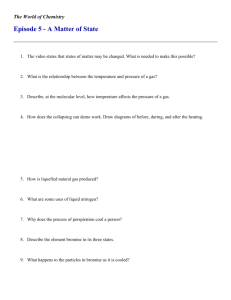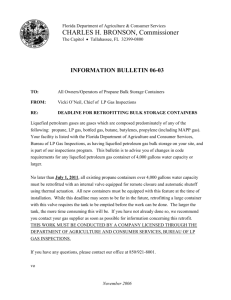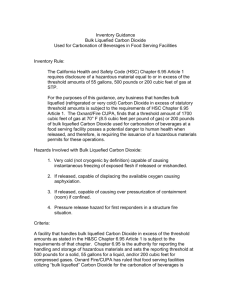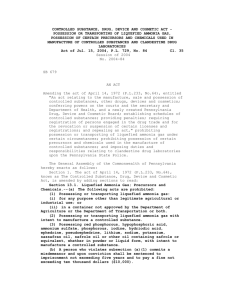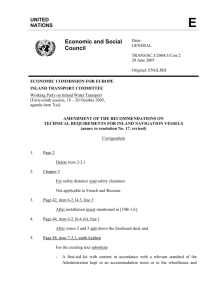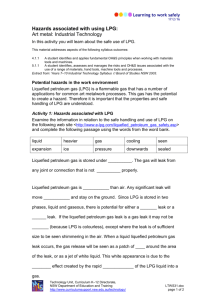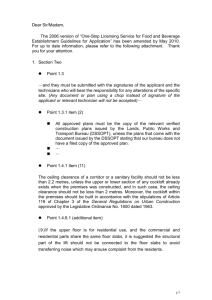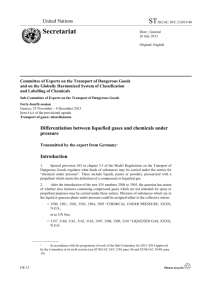Liquefied Petroleum Gas
advertisement
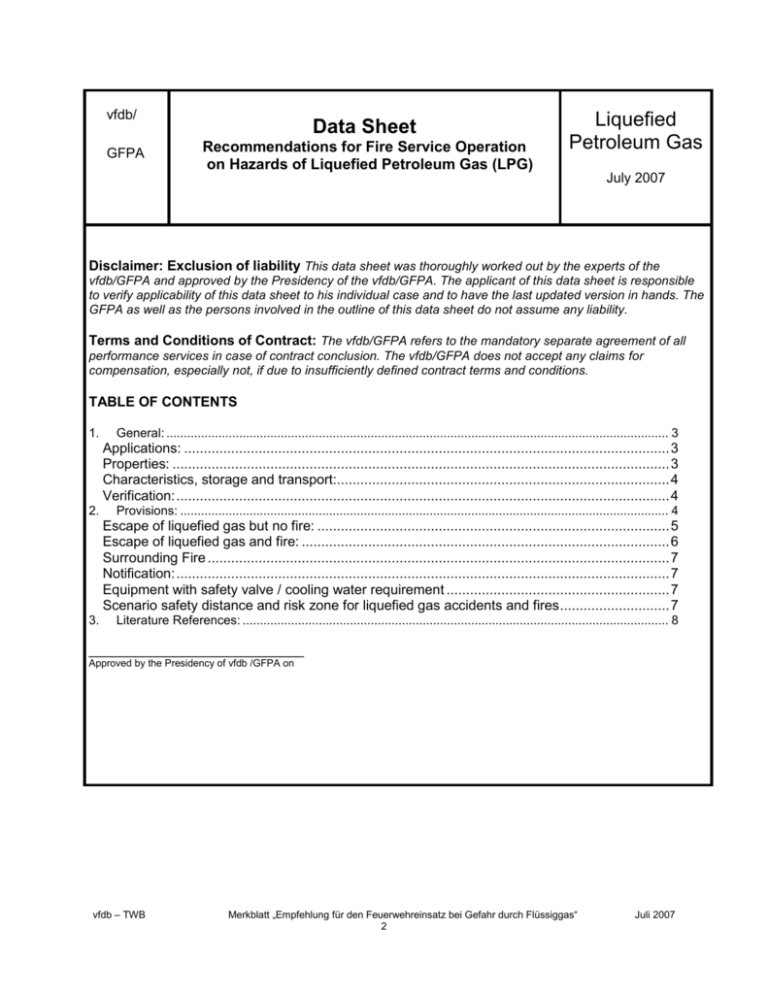
vfdb/ GFPA Data Sheet Recommendations for Fire Service Operation on Hazards of Liquefied Petroleum Gas (LPG) Liquefied Petroleum Gas July 2007 Disclaimer: Exclusion of liability This data sheet was thoroughly worked out by the experts of the vfdb/GFPA and approved by the Presidency of the vfdb/GFPA. The applicant of this data sheet is responsible to verify applicability of this data sheet to his individual case and to have the last updated version in hands. The GFPA as well as the persons involved in the outline of this data sheet do not assume any liability. Terms and Conditions of Contract: The vfdb/GFPA refers to the mandatory separate agreement of all performance services in case of contract conclusion. The vfdb/GFPA does not accept any claims for compensation, especially not, if due to insufficiently defined contract terms and conditions. TABLE OF CONTENTS 1. General: ................................................................................................................................................. 3 Applications: ............................................................................................................................ 3 Properties: ............................................................................................................................... 3 Characteristics, storage and transport:..................................................................................... 4 Verification: .............................................................................................................................. 4 2. Provisions: ............................................................................................................................................. 4 Escape of liquefied gas but no fire: .......................................................................................... 5 Escape of liquefied gas and fire: .............................................................................................. 6 Surrounding Fire ...................................................................................................................... 7 Notification: .............................................................................................................................. 7 Equipment with safety valve / cooling water requirement ......................................................... 7 Scenario safety distance and risk zone for liquefied gas accidents and fires ............................ 7 3. Literature References: ........................................................................................................................... 8 ____________________________ Approved by the Presidency of vfdb /GFPA on vfdb – TWB Merkblatt „Empfehlung für den Feuerwehreinsatz bei Gefahr durch Flüssiggas“ 2 Juli 2007 Scientific-Technical Advisory Council German Fire Protection Association – GFPA PO Box 1231, 48338 Altenberge vfdb – TWB Merkblatt „Empfehlung für den Feuerwehreinsatz bei Gefahr durch Flüssiggas“ 3 Juli 2007 1. General: The term liquefied gas refers to low boiling C3- and C4-hydrocarbons, like propane or butane as well as their mixtures or congeneric gases as for example propene and butene. The generic term for liquefied gas is LPG (liquefied Petroleum gas). In addition there are numerous mixtures of propane and butane with safety coefficients ranging between propane and butane. Applications: For gas heating in housing and industrial facilities, as fuel for combustion engines (fork lifters, vehicles). as blowing agent in spray dusters (cans) as a coolant in cooling units Properties: under pressure (5 bar to 10 bar) liquefied gas combustible and creates explosive atmospheres respiratory poison causing suffocation, non-toxic, with low narcotic effect in high concentration. liquefied gas is about 1.5 to 2.1 times heavier than air. “heavy gas behaviour” behaves similar to a liquid! Collects in (flows to) lower level sections like basements, shafts and hollows! Released in liquid phase it first evaporates, and then rapidly cools down itself and the surrounding to the boiling point and below. Risk of frostbite! Watch possible icing of control components. Gas mixes only slowly with air, and therefore remains ignitable even at a remote distance. A rollover ignition to the point of release is possible. Larger pools of liquefied petroleum gas can remain as a boiling liquid in depressions or troughs for a longer period of time. Liquefied gas floats on water, but insoluble and evaporates on the surface. (is not hazardous to waters!!) Safety Coefficients liquefied petroleum gas: propane butane standard mixture: chemical formula C3H8 C4H10 C4H10/C3H8 UN - Number 1978 1011 1965 Hommel-Data Sheet-No. 164 46 1102; 1103; 1071; 1072; 1095ff density, liquid (kg/l) 0,58 0,6 density, gaseous (g/l) 2,01 2,71 8,4 2,1 vapor pressure at 20 °C (bar) density ratio to air vfdb – TWB 1,55 2,1 Merkblatt „Empfehlung für den Feuerwehreinsatz bei Gefahr durch Flüssiggas“ 4 Juli 2007 boiling temperature (°C) - 42 - 0,5 ignition temperature (°C) 470 365 critical temperature (°C) 97 152 odor threshold (Vol.-%) 1,6 0,27 2,1 – 9,5 1,5 – 8,5 temperature classification T1 T2 T2 explosion group II A II A II A AGW (ppm) 1000 1000 1000 ETW (ppm) not specified not specified not specified EX.-range (Vol-%) 1 kg liquefied gas equals 0.5 kg TNT explosives 1 kg liquefied gas equals about 2 l liquid form about 2 l liquid equals about 500 l gaseous form 500 l gaseous can become 30,000 l ignitable gas/air mixture Characteristics, storage and transport: gaseous and in liquid form colourless Propane and butane are odourless; scent is due to odorizing. Risk classification number: 23 (ignitable gas) risk label 2.1 (red with black or white flame symbol) pressurised gas containers with a content of 0.4 kg – 6.2 kg do no have a colour coding, especially spray cans don’t. pressurised gas containers with a content of 5 kg, 12 kg and 33 kg are coloured red, grey as well as orange. Grey or orange liquefied gas cylinders are marked by red colour ring. Cylinders for camping can be marked blue. Immobile cylinder containing up to 6.4 m³ at individual buildings as well, for gas supply facilities, spherical or ground storage tanks up to and above 600 m³ too. Tank truck and rail tank wagons containing up to 110 m³. Rail tank wagons show a horizontal orange stripe (30 cm height) at level of the container’s longitudinal axis. Immobile industrial containers containing about 800 m³ - 1500 m³, for liquefied gas suppliers up to 4000 m³. Verification: detector tubes: hydrocarbon Ex-warning device 2. Provisions: vfdb – TWB Merkblatt „Empfehlung für den Feuerwehreinsatz bei Gefahr durch Flüssiggas“ 5 Juli 2007 Keep adequate safety distance! - Watch wind direction! Avoid lower grounds! Escape of liquefied gas but no fire: Approach scenario, if possible, with the wind Cordon off and secure the explosion risk zone under consideration of assumed escape direction. No open flames, do not smoke, exclude any source of ignition. Do not operate any buttons, electronic devices or mobile phones within the risk zone. Place vehicles outside the risk zone. Do not place vehicles in low grounds. Watch change of winds. Verify form of escape whether liquid or gaseous: In case of liquid escape, flow rate is higher than for escape of gas! Inspection of container volume, filling level and content. Gas can be visualised for example with an infrared camera, even after dispersion of “ fog”. if required, consult LIQUEFIED GAS SAFETY SERVICE. In case of unknown container dimensions, keep utmost operational safety distance (minimum 100 m for large scale tanks, minimum 50 m for vehicle facilities and gas cylinders). After inspection adapt safety distance to container dimensions accordingly (see table page 6). In case of gas escape in large quantities, warning of the population in endangered areas and evacuation, if required. All units in primary risk zone operate with personal protective equipment and heat protective clothing! Prepare securing squads equipped with dry powder pipe, and water cannons etc. If required, conduct gas fumes with spray or hydro shields away from endangered areas. Devices applied in a primary hazard zone needs to be explosion proof. Evacuation of risk zone if possible, diagonal/crossway to wind direction. (Definitely not in slope downwards as gas is heavier than air!) If provided, operate deluge facilities (see fire service operation, if existent). For approach put on full protective suit (e.g. with respect to other risks) Consider damage of clothing caused by freeze impact! Seal basements, low-level rooms, hollows, shafts and canals. Do not spray water into liquid phase or leaking container; “warm” water will speed evaporation! Application of middle foam or heavy foam will slow down or disrupt evaporation and extend time of gas discharge. (The foam freezes and functions as a “cover”.) Seal minor leakage with sealing cushion, stopper etc., icing of leakage, if possibly with water spray of wet textile rags. Isolate pipes; if required turn off tank heating. Inspection of risk zone by detection crews and continuous monitoring of all adjacent rooms, low-level shafts, basements, canals etc. for explosion hazard. vfdb – TWB Merkblatt „Empfehlung für den Feuerwehreinsatz bei Gefahr durch Flüssiggas“ 6 Juli 2007 bring small leaking containers outdoors. Escape of liquefied gas but no fire, intended evaporation of liquid: Basically the above applies! In addition: If possible consult expert advice. for example: LIQUEFIED GAS SAFETY SERVICE (FLÜSSIGGAS-SICHERHEITSDIENST, FSD), Tel.: +49-(0)69 75909-153 Cordon off large scale risk zone. Continuous large-scale and extensive monitoring of explosion hazard – mainly in hollows! Evaporation can be (attention!) increased by water supply! Applicable, if not bearing any risk for the vicinity or a controlled escape of gas fumes is possible. Outdoor/open air detection of explosion hazard requires particular caution! Escape of liquefied gas and fire: Attention: In case of direct flames, safety valves do not provide sufficient pressure relief! Rail tank wagons do not have safety valves! Therefore direct flames or extreme container heating bear risk of “BLEVE” (Boiling Liquid Expanding Vapor Explosion) or respectively an “ordinary” explosion associated with burst of vessel: Compressed, liquefied and under pressure dissolved gas are stored in compression vessels. These vessels are resistant up to a specific internal pressure. An increase of the internal pressure due to external heating causes burst of vessel. The total content is abruptly released. If this process refers to an abrupt release of compressed liquefied gas and rollover ignition of total content, this scenario is called “BLEVE”. For large containers, the fireball may extend to several 100 meters. Fairly empty containers may burst after fairly brief fire impact of about 10 minutes. (containers filled to more capacity require, depending on their level of filling possibly more time, as more heating is required for the liquid phase.) Larger container components may be catapulted several hundred meters, but minor parts even more than 1000 m. Burn of unprotected skin is possible up to a distance of 300 m caused by heat radiation. Considerable pressure develops and may cause damage within several hundred meters. Do not place vehicles in low grounds. In case of unknown container dimensions, keep utmost operational safety distance (minimum 100 m for large scale tanks, minimum 50 m for vehicle facilities and gas cylinders). After inspection adapt safety distance to the container dimensions accordingly (see table below). WARNING of the population etc. Find out for how long the container has been exposed to fire. Consider the BLVE hazard! Cooling of container. (see below cooling water requirements) If containers are not at risk of heating or, if sufficient cooling can be provided, ensure complete burn off as this will lower the risk of explosion! Cooling and fire extinguishing only sheltered. Employ application range of water cannon and monitor. If possible, isolate burning rail tank wagon from train. Consider risk of flash-back when extinguishing. After successful extinguishment and sealing/isolation, inspection of all adjacent rooms, shafts at lower levels, basements, canals etc. with respect to explosion hazards. Consider that safety valves may not close properly following initial response and vfdb – TWB Merkblatt „Empfehlung für den Feuerwehreinsatz bei Gefahr durch Flüssiggas“ 7 Juli 2007 subsequent cooling. Surrounding Fire assessment of explosion risk extinguish surrounding fire carry small containers to open air Notification: Emergency Medical Services Police Public Affairs Office SAFETY SERVICE LIQUEFIED GAS (FSD) +49(0)69/75909-153 (permanently manned!) Operator Equipment with safety valve / cooling water requirement container type pressurised gas cylinders pressurised gas vehicles private supply plants truck, truck plus trailer, articulated truck Rail-tank wagon storage plants, inland vessels volume up to 0,1 up to 0,1 up to 5,0 m³ up to 36 m³ cooling water(l/min) 15 15 180 1.200 safety valve Yes Yes Yes No up to 110 m³ 250 – 1000 m³ 2.500 2.000 – 150.000 No No Scenario safety distance and risk zone for liquefied gas accidents and fires container form volume (m3) largest storage quantity (kg) < 0,08 33 gas fuelled vehicles 0,1 40 25 100 200 private supply plant, compact facilities 2,7 – 6,4 1200 – 2900 100* 200 400 truck without trailer 5 t payload 6 – 11 2500 – 5000 100* 200 400 truck with trailer, articulated vehicles 20 – 36 9000 – 16000 200* 400 800 rail tank wagon from 62 26000 300* 600 1200 pressurised gas cylinders vfdb – TWB distance for risk zone prim. / operational units with sec. heat protected Prim./sec. clothing (m) (m) 25 50 100 Merkblatt „Empfehlung für den Feuerwehreinsatz bei Gefahr durch Flüssiggas“ 8 Juli 2007 storage facilities and inland vessels to 110 46000 < 250 < 1000 > 1000 100000 430000 > 430000 > 300* > 300* 500* >600 >600 >800 1500 2000 2500 * if required reduce distance for positioning of water cannons and monitors. Deviation from safety distances possible, if adequate shelter is provided. In some cases pieces of gas cylinders were catapulted up to 800 m. 3. Literature References: • Cimolino (Hrsg.): Einsatzleiterhandbuch Feuerwehr; Ecomed Verlag, Landsberg/Lech, 2000 • AIR LIQUIDE Deutschland GmbH: 1x1 der Gase; Karten Druck & Verlag GmbH, Mönchengladbach, 2005 • (Ehem.) Bayerisches Landesamt für Brand und Katastrophenschutz: Merkblatt Flüssiggas • Braun, Johann: Flüssiggastankwagen verunglückt, in: Tagungsband Feuerwehr-Forum, MI, Hürth, 2000 • DVFG: Hinweise für den Umgang mit Flüssiggas, in: Flüssiggas, 5 + 6/2000, Strobel Verlag, Arnsberg, 2000 • Fa. AGA Hamburg: Informationsschrift "Gasflaschen im Brandfall" • Gressmann, Hans-Joachim: Auch "kleine" BLEVEs können Probleme bereiten, in: Brandschutz, 6/2001, Verlag W. Kohlhammer, Stuttgart, 2001 • HMDI: Einsatz- und Ausbildungsanleitung für die Feuerwehren des Landes Hessen; RL über Gefahren und Gefahrenabwehr bei Lagerung und Transport von Flüssiggas, Wiesbaden, 2002 • Klingsohr, Kurt: Brennbare Flüssigkeiten und Gase, Rotes Heft Nr. 41, Verlag W. Kohlhammer, Stuttgart, 2002 • Unfallverhütungsvorschrift der Berufsgenossenschaften: Verwendung von Flüssiggas, BGV D34 vom Oktober 1993 in der Fassung vom 1.1.1997 vfdb – TWB Merkblatt „Empfehlung für den Feuerwehreinsatz bei Gefahr durch Flüssiggas“ Juli 2007
